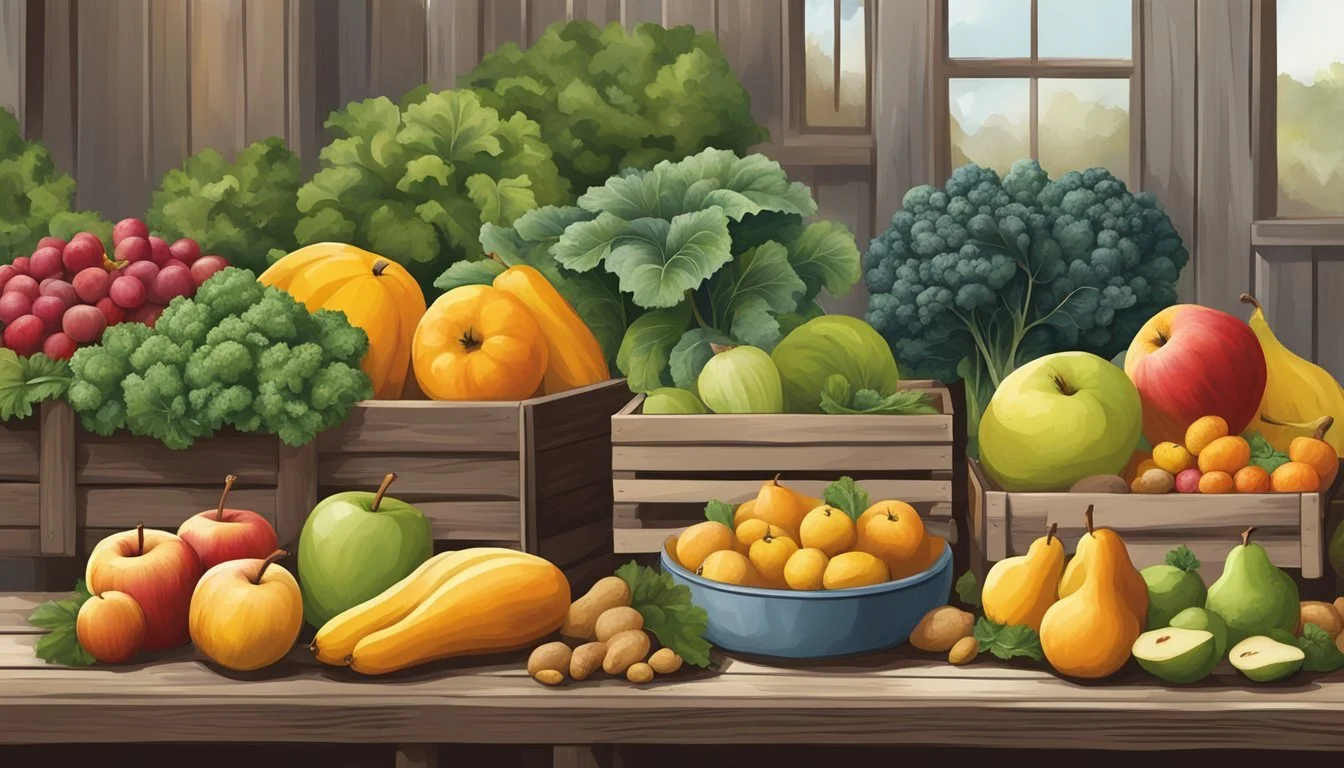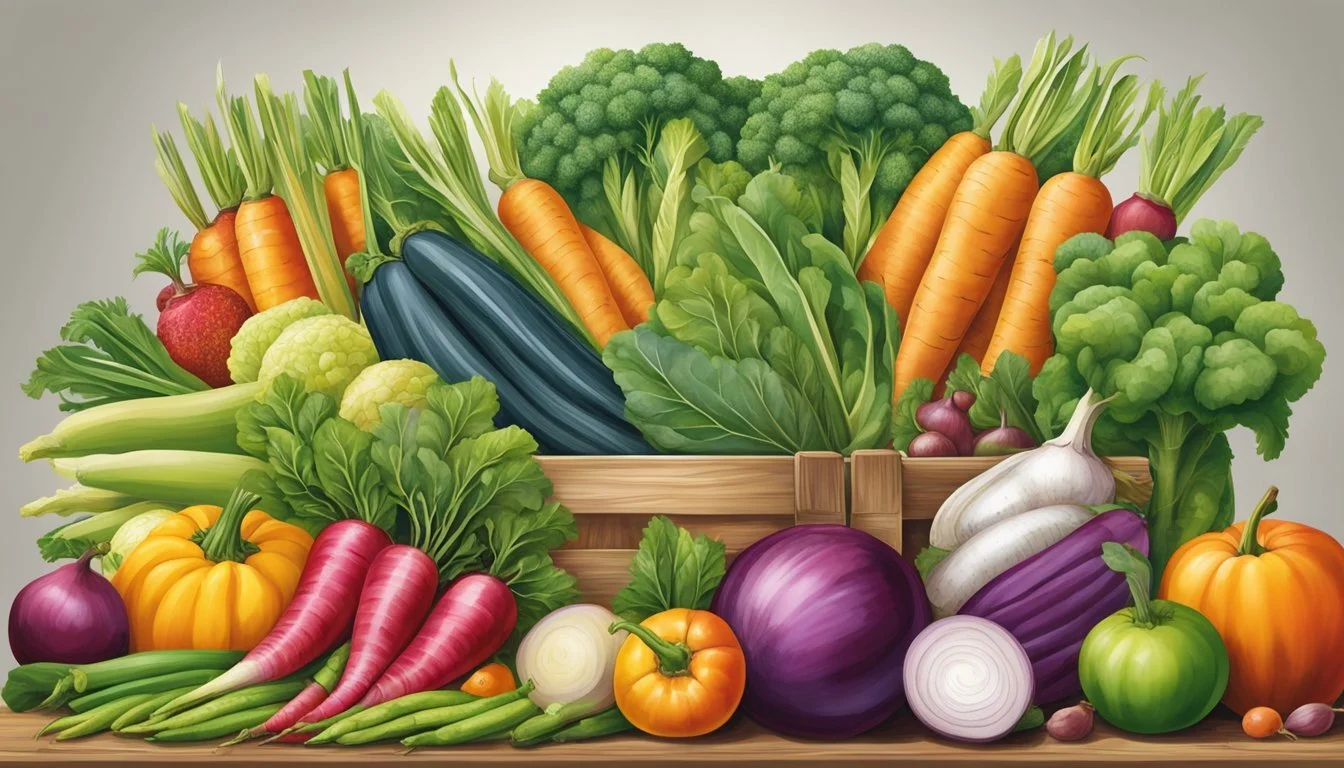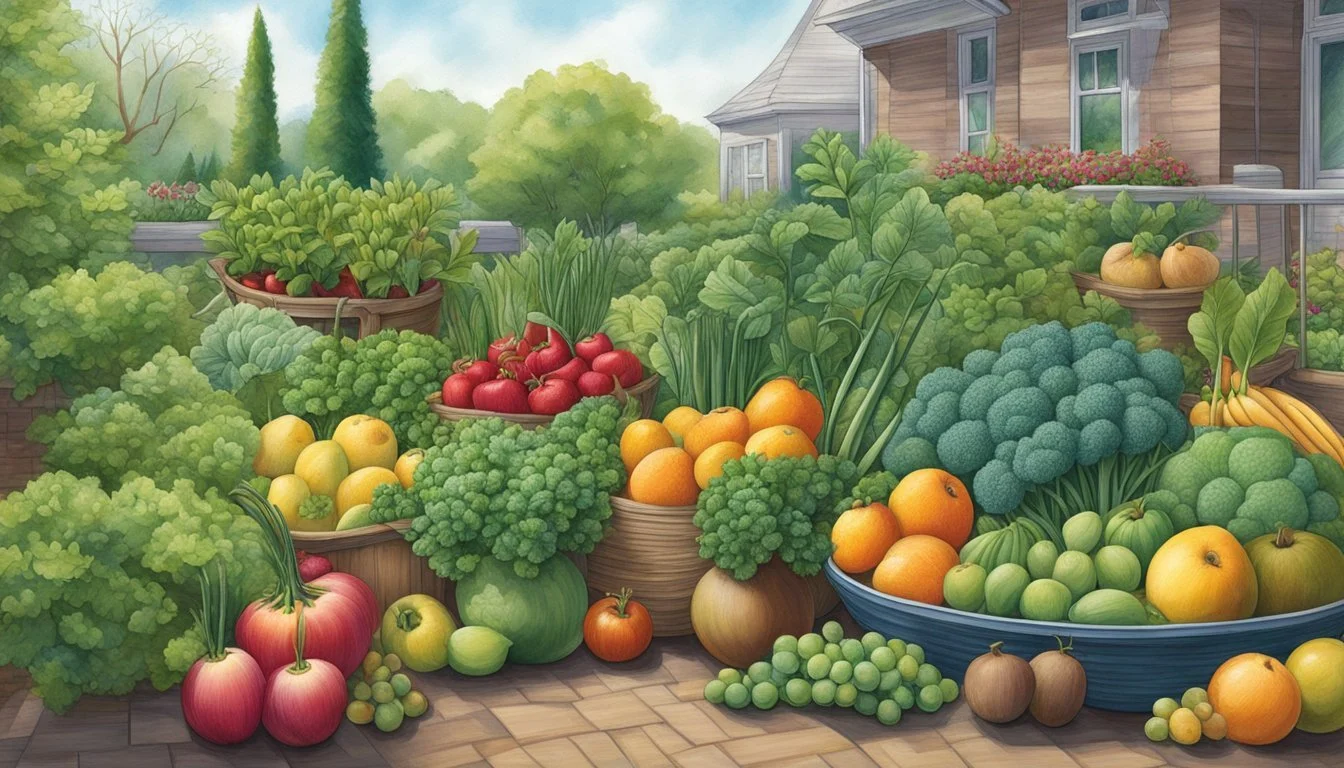Indiana Seasonal Fruit & Vegetables in February
A Guide to Fresh Produce Selection
This Article is Part of our Indiana Seasonal Fruit & Veg Calendar
Navigating the landscape of Indiana's seasonal produce in February can be an exercise in mindfulness and an appreciation for regionality. Indiana's climate presents a variety of growing conditions, with clear seasonal changes that affect the availability of fruits and vegetables. While February's chill keeps most of the outdoor farmland at rest, there are many options for fresh produce that either store well from previous harvests or are grown in controlled environments.
As the heart of winter grips the Hoosier State, residents may find comfort in stored root vegetables like potatoes and carrots (how long do carrots last?) or turn to greenhouse-grown lettuces and herbs. Citrus fruits, while not native to Indiana, are at their peak in winter and are often readily available through trade networks. Winter markets and local producers pivot to offer goods like these that suit the cold season while anticipating the spring thaw, when early plantings will once again promise a fresh bounty.
Seasonal Overview
In the heart of winter, February presents unique seasonal offerings in Indiana. The state's climate dictates the availability of fresh produce during this time, incorporating both storage crops from previous harvests and a selection of cool-season crops that thrive despite the chill.
Understanding Seasonality
Seasonality is critical in agricultural production, especially in regions like Indiana where the climate varies markedly across the seasons. In winter, the focus is primarily on stored produce and hearty vegetables that can withstand cold temperatures. Consumers should be cognizant of what typically grows during this frigid season to align their expectations and shopping habits with sustainable practices.
Winter Produce in Indiana
During the colder months, Indiana's farmers markets and stores feature produce that can endure the frosty weather. These can generally be categorized into storage crops and cold-tolerant vegetables.
Storage Crops: These include fruits and vegetables harvested during other seasons and stored for winter consumption. Common items include:
Apples (how long do apples last?)
Potatoes
Onions
Winter squash
Cold-Tolerant Vegetables: Some vegetables can survive or even thrive in cooler temperatures. In Indiana, residents can find:
Leeks
Collard greens
Spinach
The availability of fresh produce like berries or summer fruits such as peaches and plums is sparse, since February falls outside their natural growing season in Indiana. However, winter is an excellent time for citrus fruits like lemons, limes, and oranges, which are often at their peak during this month.
Seasonal Fruits
In Indiana during February, the selection of seasonal fruits is predominantly comprised of citrus variations known for their vibrant flavors and a few non-citrus fruits that manage to thrive in the winter months.
Citrus Fruits
Citrus fruits are a staple during the cooler months in Indiana, offering both a burst of flavor and a wealth of vitamin C. Key citrus fruits available include:
Blood Oranges: They have a distinctive deep red flesh and a sweet flavor with hints of raspberry.
Lemons: Known for their bright, tart taste, these are ideal for adding a fresh twist to dishes and drinks.
Oranges: A winter favorite, these fruits are sweet and juicy, perfect for snacking or juicing.
Grapefruits: This large fruit offers a bittersweet taste and is available in several varieties, ranging from white to pink and red flesh.
Other Seasonal Fruits
Apart from the citrus family, other fruits found in February in Indiana include:
Kiwi: This brown, fuzzy fruit with bright green or yellow flesh is sweet and tangy.
Pear: With several varieties, pears can range from buttery and soft to crisp and mildly sweet.
Pomegranate: Known for its jewel-like seeds (how long do seeds last?) and tangy flavor, it is often used in salads or as a garnish.
Seasonal Vegetables
In February, Indiana's seasonal vegetables are largely comprised of hearty selections that can withstand cooler temperatures. They provide robust flavors and nutritional benefits during the winter months.
Root Vegetables
Root vegetables remain a staple in February due to their ability to be stored well after harvest. Indiana residents can enjoy a variety of these subterranean gems, which include:
Carrots: Sweet and crunchy, carrots are versatile for both raw and cooked dishes.
Parsnips: Similar to carrots but with a sweeter, nuttier flavor, parsnips excel in soups and roasts.
Turnips: These can be eaten raw or cooked, offering a peppery taste when young and a starchy sweetness when mature.
Potatoes: A wide variety of potatoes is available, providing a comforting presence in many winter meals.
Celeriac (Celery Root): With a taste that mirrors traditional celery, celeriac is good mashed or used in flavor bases.
Leafy Greens
Even in the chill of February, some leafy greens persist in Indiana, favoring the cooler season to avoid bitterness:
Spinach: Tender and flavorful, spinach can be used fresh in salads or cooked down for a nutritious side.
Kale: Hardy and dense, kale holds up to cooking and is packed with vitamins and minerals.
Cruciferous Vegetables
A group of vegetables known for their health benefits and hearty textures, these remain in supply during Indiana's February:
Cabbage: It offers versatility, from raw in slaws to fermented as sauerkraut or cooked in comforting dishes.
Cauliflower: It can be roasted, steamed, or turned into creative substitutes for rice and mashed potatoes.
While the winter season may not have the abundance of the harvest months, Indiana still offers a respectable variety of vegetables that are well-suited to the colder climate. These vegetables can offer warmth and comfort in many dishes during the winter season.
Preparation and Recipes
In the heart of winter, Indiana's produce such as root vegetables and squashes offers comforting flavors ideal for hearty meals. These seasonal ingredients transform into warming dishes from nourishing side salads to savory main courses and indulgent desserts.
Salads and Side Dishes
One can create refreshing salads by combining crisp greens with slices of in-season blood oranges and roasted beets, drizzled with a vinaigrette for a bright flavor. Side dishes may feature winter squash, roasted to enhance its natural sweetness, or mushrooms sautéed with garlic and herbs, providing a rich umami flavor to any meal.
Winter Salad Ideas:
Mixed Greens: with sliced oranges, walnuts (how long do walnuts last?), and a balsamic glaze.
Warm Beet Salad: tender roasted beets paired with goat cheese and a citrus dressing.
Side Dishes to Try:
Roasted Butternut Squash: cubed and seasoned with nutmeg (how long does nutmeg last?) and cinnamon.
Sautéed Mushrooms: with thyme, perfect alongside roasted meats (What wine goes well with roasted meats?) or in grain bowls.
Main Courses
For main courses, Indiana's winter produce lends itself to robust stews and soups, brimming with a variety of root vegetables and enhanced with spices for depth. One might enjoy a thick stew featuring carrots and turnips, or a creamy soup made from pureed winter squash, each offering sustaining fare during the colder months.
Hearty Main Course Recipes:
Vegetable Stew: a medley of seasonal vegetables simmered with herbs.
Squash Soup: with a hint of apple for a touch of sweetness.
Desserts and Drinks
Finishing with desserts, one can incorporate fruits such as apples into baked goods or use citrus fruits to make flavorful tarts and cakes. For drinks, Indiana offers an opportunity to blend citrus fruits into smoothies for a revitalizing option, or to mull spices with apple cider for a warm and comforting beverage.
Dessert Inspirations:
Apple Crisp: with cinnamon and a crumbly oat topping.
Lemon Tart: featuring a buttery crust and zesty lemon curd.
Drink Recipes to Savor:
Citrus Smoothies: blending oranges and grapefruits for a vitamin C boost.
Mulled Cider: cinnamon and cloves (how long do cloves last?) warm up fresh apple cider.
Shopping and Selection
Shopping for seasonal produce in February in Indiana calls for a well-informed approach to ensure that one picks the freshest and highest quality fruits and vegetables. Not all produce is available year-round, so knowing what is in season and where to get it is crucial.
Visiting Farmers Markets
Farmers markets provide a platform for consumers to purchase directly from growers, ensuring the produce is as fresh as it can be. In Indiana, seasonal produce available in February may be limited due to the cold climate, but some hardy vegetables are typically harvested. Shoppers should check local market schedules as many operate on limited winter hours or dates.
Choosing Quality Produce
When selecting produce, it is essential to examine the fruits and vegetables for signs of freshness:
Color: Look for vibrant, naturally rich colors which are often an indicator of good quality.
Texture: Produce should feel firm to the touch, avoiding any soft spots or blemishes.
Aroma: Fresh fruits and vegetables often have a distinct, pleasant smell; this is especially true for citrus fruits.
For raw consumption, making sure fruits and vegetables are free from bruising or damage is important as it affects both taste and nutritional value. Here is a brief table on what to look for in February produce:
Produce What to look for Apples Firmness, absence of wrinkles, and rich coloring Citrus fruits (lemons, oranges) Bright color, firmness, and a slightly heavy feel for size
Shoppers are encouraged to ask farmers or sellers questions about the produce to make better-informed selections.
Health and Nutrition
When it comes to health and nutrition in February, Indiana residents have a bounty of seasonal produce to choose from that can enrich their diet. Despite the cold weather, certain fruits and vegetables thrive and are available fresh during this time. Consuming raw fruits and vegetables ensures the retention of vital nutrients and enzymes, often diminished during cooking.
Fruits: In Indiana, citrus fruits like oranges, which are shipped in at their peak, offer a burst of flavor and are packed with Vitamin C, essential for immune system support during the colder months.
Vegetables: Root vegetables such as carrots and turnips, which can be stored well into winter, provide a versatile flavor profile—sweet when raw and aromatic when cooked—alongside a host of nutrients including fiber, Vitamin A, and potassium.
The consumption of these seasonal foods supports a balanced diet, as they are conducive to maintaining variety and nutritional adequacy. A rich intake of fruits and vegetables is associated with a lower risk of many health conditions, including heart disease, obesity, and certain types of cancer.
Here is a simple breakdown of February's seasonal offerings in Indiana and their health benefits:
Produce Type Benefit Citrus Fruits High in Vitamin C; boosts immune function Root Vegetables Good source of fiber; promotes digestive health Leafy Greens High in iron and folate; supports blood health
Incorporating these foods into daily meals can be a simple yet effective way to enhance overall health and ensure a well-rounded intake of essential vitamins and minerals. The flavors of these fruits and vegetables can range widely, providing an enjoyable and healthful eating experience.
Season Transitioning
As Indiana transitions from winter into spring, local produce availability begins to change. February marks a period of anticipation for new growth, with gardeners and farmers preparing for the upcoming shifts in agricultural rhythms.
From Winter to Spring
In February, Indiana is nearing the end of its winter season. This month is critical for starting seeds indoors, especially for cool-season vegetables that will be transplanted in early spring, most notably in April. The groundwork for spring crops begins now, with broccoli, cauliflower, and cabbage seeds often started five to seven weeks prior to moving them outdoors.
While the frosty conditions of winter start to ease, the array of available produce remains predominantly winter-centric. Root vegetables and hardy greens are still prevalent, with the last of the winter storage crops being utilized. However, this month also sees the preparation for spring produce; farmers may begin tilling the soil and enriching it with compost, setting the stage for the first plantings as soon as the threat of hard frosts diminishes.
In terms of fruits, February continues to favor citrus. Lemons, limes, and oranges are commonly found at their peak, offering bright flavors even as the climate remains cool and the days slowly grow longer.
It's worth noting that this time of year is used to gauge the health of perennial plants and prepare fruit trees for their spring growth. Pruning may take place to encourage productive fruiting in the months ahead, particularly for the state's apple and peach orchards as they ready themselves for blossoming in early spring.
Gardening Tips for Hoosiers
As February takes hold in Indiana, gardeners should focus on setting the stage for a fruitful season. This is a crucial time for preparing beds, starting seeds, and planning crop rotations.
Preparing for the Planting Season
Successful gardening begins well before the first seedlings are placed in the soil. Hoosiers should take advantage of the cool February days to prepare for the planting season ahead.
Indoor Seed Starting: Gardeners can start seeds indoors for crops like tomatoes and various herbs. It is recommended to begin with cool-season vegetables such as lettuce and radishes, which will be ready to transplant when the weather warms.
Herbs: Start basil, parsley, and cilantro indoors under grow lights.
Lettuce: Opt for varieties suitable for early spring planting and begin seeds indoors.
Soil Preparation: Checking the soil moisture and amending with compost can enhance the garden’s foundation. Conduct a soil test to determine pH and nutrient levels for optimal plant growth.
Planning and Organization:
Task Details Garden Layout Sketch plans for where to place each crop, considering sunlight and crop rotation. Plant Spacing Use recommended spacing to ensure healthy growth and yield. Crop Selection Choose varieties of radishes and rhubarb that have proven successful in Indiana’s climate.
Seed Testing and Purchase: For those with leftover seeds, perform a germination test to ensure viability. Buy new seeds as early as possible for the best selection, focusing on preferred vegetables like tomatoes and staple early growers like rhubarb.
As Indiana's gardeners tend to their February tasks with diligence, they lay the groundwork for an abundant growing season.









